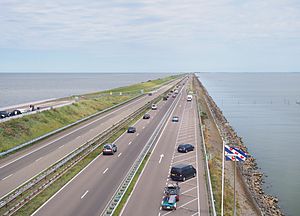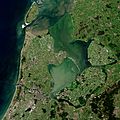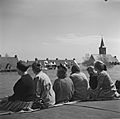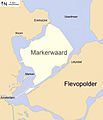Zuiderzee Works facts for kids
The Zuiderzeewerken (which means Zuiderzee Works) is a huge project in the Netherlands. It involves building dams, creating new land, and draining water. This amazing project happened during the 1900s.
People had ideas for these works as early as the 1600s. But it took a very bad flood in 1916 for the Dutch government to agree to pay for it. Today, the Zuiderzeewerken is considered one of the Seven Wonders of the Modern World.
Contents
Building the Main Dams
The first step was to build large dams, also called dykes. These dykes were made to separate the South Sea (called Zuiderzee in Dutch) from the North Sea.
The most important dam was the Afsluitdijk. This name means 'closure dyke'. It is a massive 32 kilometers (20 miles) long. When it was finished in 1932, the South Sea was completely closed off. It then became a freshwater lake known as the IJsselmeer.
Creating New Land: Polders
After building the main dams, the next part of the project was to create new land. This is called land reclamation. It involved building more dams and then pumping out the water from inside them.
The new land that was created is called a polder. These polders provide new areas for farming. They also help protect the country from floods. This is because the IJsselmeer lake becomes smaller, holding less water.
How Water is Managed
The Afsluitdijk has special gates and sluices at its ends. The gates are called locks. They can be opened to let ships pass through the dam.
The sluices are used to let water out of the IJsselmeer. This is very important. If the sluices did not open, the lake would fill up too much. It would then flood the nearby countryside. This is because rivers constantly flow into the IJsselmeer. Also, water is always being drained from the polders into the lake.
Related pages
Images for kids









